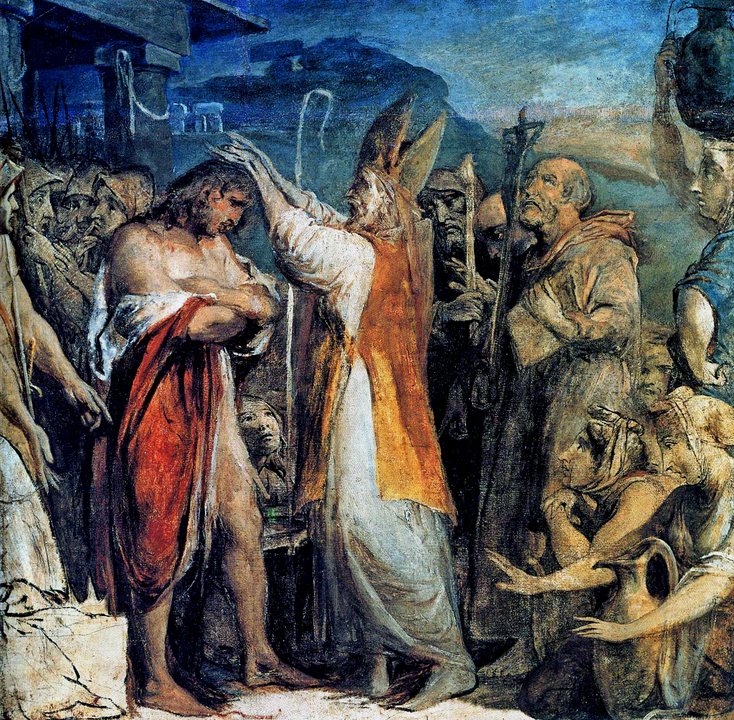St. Patrick to this day is often depicted carrying a crozier, a staff with an elaborately curved top meant to recall a shepherd’s staff that has become the symbol of a bishop’s office. Patrick was a bishop, but his crozier was not just symbolic. If you need a staff to support yourself, it is best if it has a pointed end so that it can stick into the ground.
As Patrick was preaching, he would emphasize his points by lifting his crozier and sticking it into the ground. Caught up in his sermon as he stood beside the royal baptismal candidate, Patrick did not notice that when he lifted his crozier he stuck it into the king’s foot. With a warrior’s self-discipline, Angus did not even flinch.
As Patrick conducted the baptism, he was appalled to see that the king was standing in a pool of blood.
Afterwards, the remorseful bishop asked King Angus why he didn’t say anything. Angus told him that he just thought it was part of the ceremony, that just as Christ’s feet were pierced in the crucifixion that he was being baptized into, his foot had to be pierced as well.
“Patrick was deeply moved by this Irish hardiness,” says the author, “so ready to suffer to receive the joys of heaven, though brought on in this instance through an error of his, an error which brought unnecessary pain to a member of his flock.”
And then Fitzpatrick applies the lesson: Sometimes pastors hurt people who are in their care.
Sometimes this is an evil act, as in the sexual abuse scandal that has been plaguing the Catholic church and that we now know has its counterpart among Protestants. Fitzpatrick emphasizes that victims of this or other kinds of abuse should not just stoically suffer, as Angus did. They should report the matter to ecclesiastical authorities (the bishop, or we Protestants would say, the elders or the district president) and, in cases of sexual assault, the police.
There are less dramatic kinds of harm, as well, such as false teaching and professional misbehavior. Instead of suffering in silence, parishioners should certainly talk to the pastor and perhaps other authorities about them.
When we are in church, we are not meant to stand in a pool of our own blood.
But there is a much lesser kind of harm, as when a pastor jabs you with an insensitive remark or pierces you with an unkind word or draws figurative blood with a hurtful action. Such things are usually unintentional, like what St. Patrick did with his crozier. He felt terrible when he realized what he had done, and he wanted Angus to talk with him to work out any bad feelings. So it can be with us.
Finally and most commonly, there are the completely unintentional actions of a pastor that we might find bothersome or annoying, the kind of quirks and imperfections that all human beings can display. For these, we should not quit going to church, move to a different congregation, try to get the pastor removed, gossip about it to our friends, or even (in my view) bring it up to the pastor, who might find the confrontation hurtful himself.
Rather, we should suck it up, get a sense of perspective, honor the pastoral office, and behave like King Angus.

Stained glass window, St. Patrick Catholic Church, Junction City, Ohio, photograph by Nheyob – Own work, CC BY-SA 4.0, https://commons.wikimedia.org/w/index.php?curid=39732088
“Baptism of the King of Cashel,” By James Barry (1741 — 1806) of Cork – https://www.confessio.ie/more/article_moss/image27#, Public Domain, https://commons.wikimedia.org/w/index.php?curid=68064452














